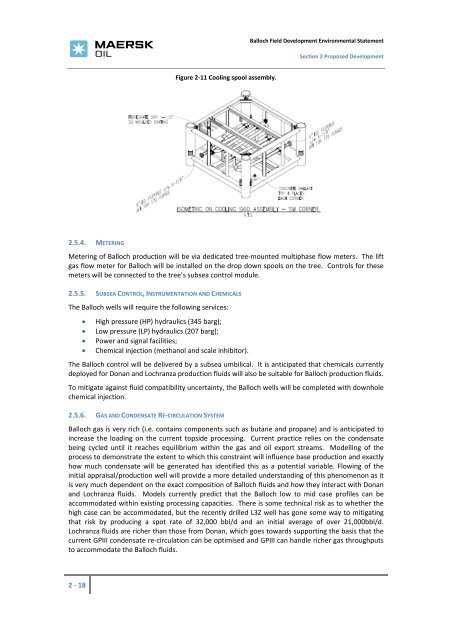Environmental Statement - Maersk Oil
Environmental Statement - Maersk Oil
Environmental Statement - Maersk Oil
Create successful ePaper yourself
Turn your PDF publications into a flip-book with our unique Google optimized e-Paper software.
2.5.4. METERING<br />
2 ‐ 18<br />
Figure 2‐11 Cooling spool assembly.<br />
Balloch Field Development <strong>Environmental</strong> <strong>Statement</strong><br />
Section 2 Proposed Development<br />
Metering of Balloch production will be via dedicated tree‐mounted multiphase flow meters. The lift<br />
gas flow meter for Balloch will be installed on the drop down spools on the tree. Controls for these<br />
meters will be connected to the tree’s subsea control module.<br />
2.5.5. SUBSEA CONTROL, INSTRUMENTATION AND CHEMICALS<br />
The Balloch wells will require the following services:<br />
High pressure (HP) hydraulics (345 barg);<br />
Low pressure (LP) hydraulics (207 barg);<br />
Power and signal facilities;<br />
Chemical injection (methanol and scale inhibitor).<br />
The Balloch control will be delivered by a subsea umbilical. It is anticipated that chemicals currently<br />
deployed for Donan and Lochranza production fluids will also be suitable for Balloch production fluids.<br />
To mitigate against fluid compatibility uncertainty, the Balloch wells will be completed with downhole<br />
chemical injection.<br />
2.5.6. GAS AND CONDENSATE RE‐CIRCULATION SYSTEM<br />
Balloch gas is very rich (i.e. contains components such as butane and propane) and is anticipated to<br />
increase the loading on the current topside processing. Current practice relies on the condensate<br />
being cycled until it reaches equilibrium within the gas and oil export streams. Modelling of the<br />
process to demonstrate the extent to which this constraint will influence base production and exactly<br />
how much condensate will be generated has identified this as a potential variable. Flowing of the<br />
initial appraisal/production well will provide a more detailed understanding of this phenomenon as it<br />
is very much dependent on the exact composition of Balloch fluids and how they interact with Donan<br />
and Lochranza fluids. Models currently predict that the Balloch low to mid case profiles can be<br />
accommodated within existing processing capacities. There is some technical risk as to whether the<br />
high case can be accommodated, but the recently drilled L3Z well has gone some way to mitigating<br />
that risk by producing a spot rate of 32,000 bbl/d and an initial average of over 21,000bbl/d.<br />
Lochranza fluids are richer than those from Donan, which goes towards supporting the basis that the<br />
current GPIII condensate re‐circulation can be optimised and GPIII can handle richer gas throughputs<br />
to accommodate the Balloch fluids.








